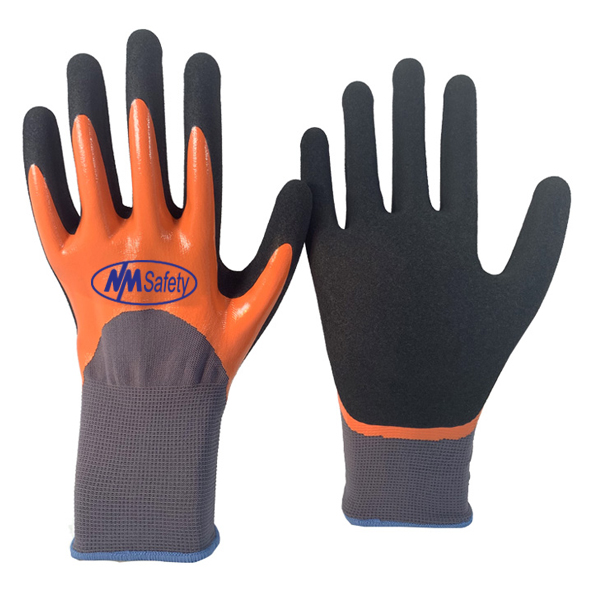What is nitrile?
Nitrile is an organic substance in which the carbon and nitrogen molecules are joined by triple bonds rather than a substance. As a result, there are different types of nitriles. Nitrile-coated gloves are made of butadiene-acrylonitrile, but you can see why we like to refer to it as nitrile on our packaging.
We need to travel back to 1782, to the laboratories of German-Swedish chemist Carl Wilhelm Scheele, to discover where nitrile originates. Scheele is a well-known chapter in American history of science, having discovered several chemical elements and compounds. These chemicals include Citric and glycerides. We are interested here as it is the first participant of the nitrile clan. The increasing adoption in the business for a replacement for latex gloves sparked the creation. The endurance and stability of nitrile-coated gloves explain why they are so popular.
Nitrile, vinyl, and latex gloves are the three most common forms of protective gloves. Today, we'll look at nitrile-coated gloves and why they've become the most preferred choice in many residential and retail environments.
Nitrile coated gloves:
Nitrile safety gloves are composed of a synthetic fibers polymer called nitrile. The primary function of these gloves is to protect your hands.
Nitrile rubber is a petrochemical waste that is present in laboratories. Because of its synthetic origin, nitrile is significantly more easily accessible and renewable than latex or natural rubber.
Some key points of Nitrile double half coated gloves:
There are some crucial key points that you need to know about nitrile double half coated gloves:
- Nitrile gloves persist a lot longer, although they will deteriorate with time. If you want your package of nitrile gloves to last a long time, keep them out of the bright sun and away from heat. They have more durability time than other gloves.
- Washable nitrile-coated glovesare now available. Nitrile gloves are chemically resistant.
- Nitrile-coated glovesprotect the user's hands. The nitrile substance protects the wearer's hands from infection and prevents them from infecting any product or surfaces they come into contact with.
- Nitrile gloves are also extensively utilized in the medical profession because of their great punctured resistance qualities.
- Nitrile gloves are a fantastic option for regular work gloves because they protect your hands from different compounds.
- Nitrile gloves are biodegradable. They must be placed in a specific recycling bin rather than in your regular trash bin.
- Latex gloves have a higher rate of reaction than nitrile-coated Nitrile-coated gloves are a better option for a person who has skin problems.
- Latex gloves are weaker than nitrile-coated gloves. They're also more chemically resistant, have a firmer puncture strength, and are available in trade-specific colors.
How to select the best nitrile double half coated glove:
Nitrile gloves are increasingly gaining popularity among many businesses when it comes to selecting the best gloves. Nitrile grip gloves are the best gloves for many fields. If you're having trouble finding nitrile gloves for you, check out the advice from our nitrile glove specialists below.
Industrial vs. Exam Nitrile Gloves:
Before you go out and buy any old pair of nitrile gloves, think about why to wear them.
Nitrile-coated gloves have two types:
- Commercial grade
- Medical grade.
Commercial grade nitrile gloves:
This type of nitrile glove is ideal for applications involving the management of organic solvents. Automotive, cleaning, and tattoo shops are just a few sectors that use nitrile gloves. Because industrial-strength nitrile gloves are chemically resistant, they are ideal for many professions.
Medical Grade Nitrile Gloves-:
If your job requires you to deal with biological hazards or other chemicals, you should wear medical-grade nitrile gloves. Healthcare, health facilities, dentistry services, and other labs are the most common places to find nitrile grip gloves. Medical-grade nitrile gloves also help determine that they fulfill FDA criteria, ensuring that each glove has the sturdiness required for your clear objective. Nitrile grip gloves help protect workers from chemotherapeutic drugs, body fluids, and blood-borne diseases such as the Human Immunodeficiency virus.
Nitrile glove size and color:
Many of our consumers misunderstand the value of a well-fitting glove.
The majority of disposable gloves on the marketplace now come in distinct and irregular sizes. When you have the right nitrile glove size, you'll be able to improve your ability while still having enough flexibility to do the work. Nitrile- coated gloves are also available in distinctive colors. You can use blue nitrile gloves for medical purposes and black nitrile gloves for automobiles. Colorful nitrile gloves can help brighten up a dull workplace.
The thickness of Nitrile double half coated gloves:
Most industrial-grade nitrile gloves are 6 to 8 millimeters thick. The additional thickness provides an extra layer of protection against severe substances and environmental issues. The thinner or smaller the size of your nitrile gloves, the more mobility and elasticity you'll have.
This nitrile glove is exceptionally tear-proof and famous among tattooists, with a thickness of nearly five millimeters.
Steps to wash nitrile coated gloves:
The steps to clean the nitrile coated gloves are here:
Step No 1:
Fill a bowl with new soapy water that has been cleaned and sanitized.
Step No 2:
Remove the gloves from your hands and put them in soapy water to remove all the chemicals.
Step NO 3:
Lightly massage the nitrile gloves in the water and soap while wearing thick gloves to eliminate contaminants.
Step NO 4:
Wash your hands after removing your heavy gloves. After that, wipe and disinfect the thick gloves. Be sure to wash your hands afterward.
Step No 5:
Any glove used for medicinal or dangerous chemical use should not be washed and reused.
Conclusion:
Nitrile-coated gloves are becoming popular day by day. It only happens due to its high-quality properties. If you want to buy perfectly fitted nitrile-coated gloves, visit NM safety. NM safety is famous for its high-quality gloves.









